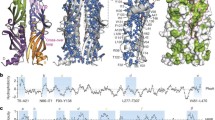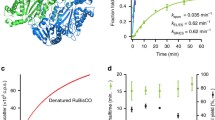Abstract
It has been verified that prochymosin is characterized by a two-stage refolding: dilution of unfolded protein into pH 11 buffer followed by neutralization at pH 8; the high-pH step is indispensable. Here we demonstrate that one-stage refolding around pH 8 can be achieved when GroE or 10-fold molar excess (rather than catalytic concentration) of protein disulfide isomerase (PDI) over prochymosin is present. The helping effect varies with the oxidation states of prochymosin. GroE and PDI increase the reactivation of the unfolded, partially reduced and the unfolded, oxidized prochymosin from 5% to 40% and from 50% to 100%, respectively. For the unfolded and fully reduced prochymosin, GroE does not have a positive effect, whereas PDI promotes renaturation from 2% to 28%. Based on our previous and present observations, we propose that at pH 8 there may be two kinds of incorrect interactions within and between prochymosin polypeptides leading to unproductive pathways: one prevents disulfide rearrangement, which can be avoided by high pH; the other interferes with acquisition of native conformation, which can be relieved by GroE and PDI.
Similar content being viewed by others
REFERENCES
Cai, H., Wang, C. C., and Tsou, C. L. (1994). J. Biol. Chem. 269, 24550–24552.
Chen, H., Zhang, G., Zhang, Y., Dong, Y., and Yang, K. (2000). Biochemistry, 39, 12140–12148.
Emtage, S., Angal, S., Doel, M. T., Harris, T. J. R., Jenkins, B., Lilley, G., and Lowe, P. A. (1983). Proc. Natl. Acad. Sci. USA 80, 3671–3675.
Fenton, W. A. and Horwich, A. L. (1997). Protein Sci. 6, 743–760.
Goloubinoff, P., Diamant, S., Weiss, C., and Azem, A. (1997). FEBS Lett. 407, 215–219.
Harris, T. J. R., Lowe, P. A., Lyons, A., Thomas, P. G., Eaton, M. A. W., Millican, T. A., Patel, T. P., Bose, C. C., Carey, N. H., and Doel, M. T. (1982). Nucleic Acids Res. 10, 2177–2187.
Hillson, D. A., Lambert, N., and Freedman, R. B. (1984). Meth. Enzymol. 107, 281–294.
Huang, K., Zhang, Z., Liu, N., Zhang, Y., Zhang, G., and Yang, K. (1992). Biochem. Biophys. Res. Commun. 187, 692–696.
Jakob, U. and Buchner, J. (1994). Trends Biochem. Sci. 19, 205–211.
LaMantia, M. L. and Lennarz, W. J. (1993). Cell 74, 899–908.
Landry, S. J. and Gierasch, L. M. (1991). Biochemistry 30, 7359–7362.
Lowry, O. H., Rosebrough, N. F., Farr, A. L., and Randarl, A. T. (1955). J. Biol. Chem. 193, 265–275.
Marston, F. A. O., Lowe, P. A., Doel, M. T., Schoemaker, J. M., White, S., and Angal, S. (1984). Bio/technology 2, 800–804.
Martin, J., Langer, T., Boteva, R., Schramel, A., Horwich, A. L., and Hartl, F. U. (1991). Nature 352, 36–42.
Mellor, J., Dobson, M. J., Roberts, N. A., Tuite, M. F., Emtage, J. S., White, S., Lowe, P. A., Patel, T., Kingsman, A. T., and Kingsman, S. M. (1983). Gene 24, 1–14.
Nishimori, K., Kawaguchi, Y., Hidaka, M., Uozumi, T., and Beppu, T. (1982). Gene 19, 337–344.
Sugrue, R., Marston, F. A. O., Lowe, P. A., and Freedman, R. B. (1990). Biochem. J. 271, 541–547.
Tang, B., Zhang., S., and Yang, K. (1994). Biochem. J. 301, 17–20.
Tsulagoshi, N., Ando, Y., Tomita, Y., Vchida, R., Takemure, T., Sasaki, T., Yamata. H., Udaka, S., Ichihara, Y., and Takahachi, K. (1988). Gene 65, 285–292.
Wang, C. C. and Tsou, C. L. (1993). FASEB J. 7, 1515–1517.
Wang, C. C. and Tsou, C. L. (1998). FEBS Lett. 425, 382–384.
Wei, C., Tang, B., Zhang, Y., and Yang, K. (1999). Biochem. J. 340, 345–351.
Yao, Y., Zhou, Y. C., and Wang, C. C. (1997). EMBO J. 16, 651–658.
Zhang, Y., Li, H., Wu, H., Dong, Y., Liu, N., and Yang, K. (1997). Biochim. Biophys. Acta 1343, 278–286.
Author information
Authors and Affiliations
Rights and permissions
About this article
Cite this article
Wei, C., Zhang, Y. & Yang, K. Chaperone-Mediated Refolding of Recombinant Prochymosin. J Protein Chem 19, 449–456 (2000). https://doi.org/10.1023/A:1026593113633
Published:
Issue Date:
DOI: https://doi.org/10.1023/A:1026593113633




